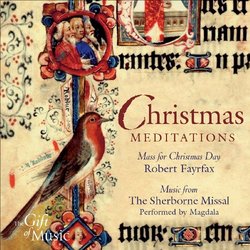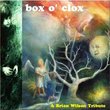| All Artists: Magdala Title: Christmas Meditations Members Wishing: 0 Total Copies: 0 Label: The Gift of Music Original Release Date: 1/1/2004 Re-Release Date: 3/3/2005 Genres: Special Interest, Pop, Classical Styles: Holiday & Wedding, Vocal Pop, Opera & Classical Vocal Number of Discs: 1 SwapaCD Credits: 1 UPC: 658592110029 |
Search - Magdala :: Christmas Meditations
 | Magdala Christmas Meditations Genres: Special Interest, Pop, Classical
Christmas Meditations Music for a Medieval Christmas Mass Join the 15th century Benedictine monks of Sherborne Abbey as they sing plainchant from the great service book or missal created for the Abbey in 1400-07. This litu... more » |
Larger Image |
CD Details
Synopsis
Product Description
Christmas Meditations Music for a Medieval Christmas Mass Join the 15th century Benedictine monks of Sherborne Abbey as they sing plainchant from the great service book or missal created for the Abbey in 1400-07. This liturgical reconstruction researched by Gift of Music was recorded in Magdalen College chapel by the Magdala choir. Our knowledge of High Mass on Christmas Day as it might have been celebrated at Sherborne Abbey in c.1520 comes from the highly ornate Sherborne Missal (British Library MS Add.74236). From this manuscript it is possible to reconstruct the service as it would have been performed at Sherborne Abbey in this period. The melodies of the chants are supplied in the main from another Benedictine manuscript, the Crowland Gradual (British Library, MS Egerton 3759), except for the Pater noster and the 'incipits' (starting phrases for the Gloria and Credo), which are from the Missal. For religious communities inhabiting monasteries and priories across medieval England, a large part of the day was occupied by the singing of the eight services of the Divine Office and one or more Masses. The music of monastic worship ranged from prayers sung to simple tones to elaborate and extended chants for important feast days. The main chants of the Mass were divided into two types: the texts of the Mass Ordinary chants (Gloria, Credo, Sanctus, Benedictus and Agnus Dei) remained constant, while the texts and melodies of the Mass Proper chants (Introit, Gradual, Alleluya, Sequence, Offertory and Communion) altered daily or weekly in accordance with the season or feast. From the late fifteenth century up to the dissolution of the monasteries in the 1530s, monastic houses across England began increasing to use choirs of secular singers within the liturgy. These choirs of men and boys sang polyphony alongside the plainchant of the monks enhancing the liturgy at the daily Lady Mass and also at principal services in quire, such as High Mass on a major festival. There is little surviving evidence regarding the cultivation of polyphonic music at Sherborne Abbey in Dorset but it seems more than likely that the abbey would have employed a secular choir for the performance of polyphony in this way during the last few decades of the Middle Ages. This disc is therefore a reconstruction of High Mass on Christmas Day as it might have been celebrated at Sherborne Abbey in c.1520. Our knowledge of the plainsong propers for the Mass comes from the highly ornate Sherborne Missal (British Library, MS Add.74236) which contains the full texts of the Mass throughout the year. From this manuscript it is possible to reconstruct the service as it would have been performed at Sherborne Abbey in this period. The melodies of the chants are supplied from another Benedictine manuscript, the Crowland Gradual (British Library, MS Egerton 3759). The movements of the Mass Ordinary are taken from Fayrfax's 'Tecum principium', a five part Mass based on a plainsong Vespers antiphon for Christmas. Robert Fayrfax (d.1521), was a gentleman of the Chapel Royal and was also linked to the musical establishment at the Benedictine abbey of St Albans. He was one of the finest composers of his generation, his Masses, Magnificats and votive antiphons surviving in a number of manuscripts from institutions across the country. Recorded in Saint Giles' church, Bruges, and Magdalen College, Oxford, July 2004 Liturgical reconstruction by Anna Parsons MAGDALA, directed by Dr David Skinner, was formed in 2002 as the first professional mixed-voice choir based at Magdalen College, Oxford. The choir is currently one of the finest ensembles of its type in Oxford and Cambridge, and specializes in music of the 15th and 16th centuries.
Similar CDs
| Box O' Clox A Brian Wilson Tribute Genre: Pop Label: Cmp | |

 Track Listings (11) - Disc #1
Track Listings (11) - Disc #1